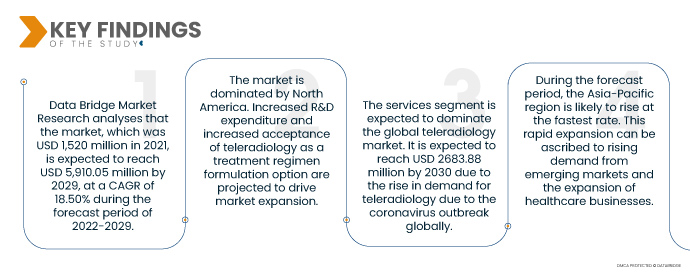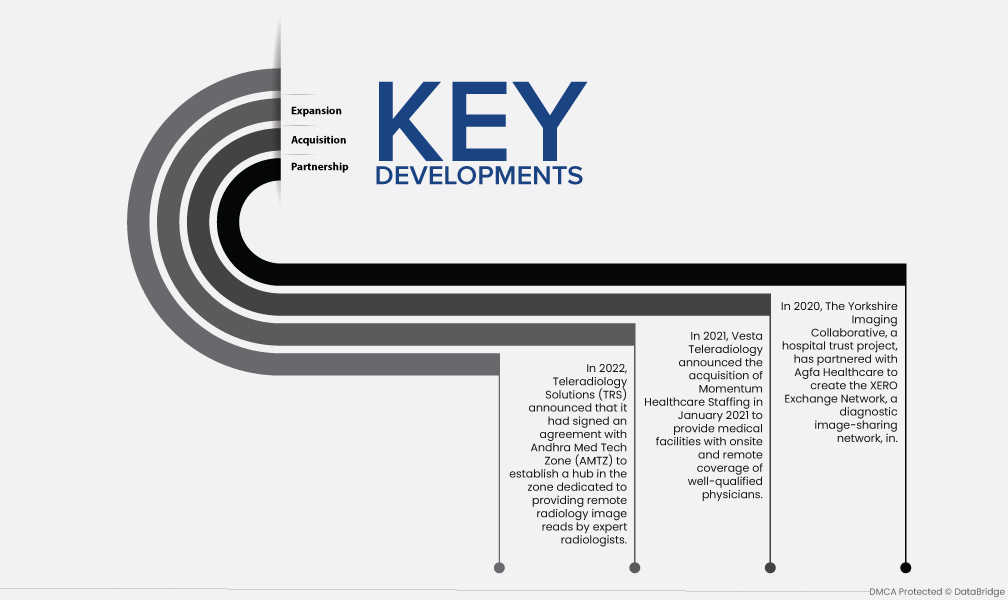Le secteur de la téléradiologie se divise en hôpitaux, centres de chirurgie ambulatoire, centres de diagnostic et autres, en fonction de l'utilisateur final. Les centres de chirurgie ambulatoire représentent la majeure partie du chiffre d'affaires et devraient connaître la plus forte croissance au cours de la période de prévision. Cela s'explique par le fait qu'ils améliorent l'efficacité des soins, permettant aux patients de passer moins de temps dans les établissements de santé. De plus, la préférence croissante des patients pour les centres de chirurgie ambulatoire pour un diagnostic rapide et facile, ainsi que l'augmentation de l'utilisation des services de téléradiologie dans ces centres, devraient stimuler la croissance du marché au cours de la période de prévision.
Accéder au rapport complet sur https://www.databridgemarketresearch.com/reports/global-teleradiology-market
Data Bridge Market Research analyse que le marché de la téléradiologie , qui s'élevait à 1 520 millions USD en 2021, devrait atteindre 5 910,05 millions USD d'ici 2029, avec un TCAC de 18,50 % sur la période de prévision 2022-2029. L'augmentation du financement du gouvernement fédéral pour favoriser l'adoption de ces solutions a encore influencé le secteur. De plus, l'augmentation des dépenses de santé, le développement des infrastructures de santé et la demande accrue de soins élargis sont autant de facteurs qui profitent au secteur de la téléradiologie.
La sensibilisation croissante à l'application de la téléradiologie devrait stimuler le taux de croissance du marché.
Les applications de téléradiologie comprennent la téléconsultation, la télésurveillance et le télédiagnostic, qui permettent aux radiologues d'exercer leurs fonctions avec plus d'efficacité. La téléradiologie offre des solutions efficaces sur site et une interprétation en temps réel sur les réseaux cloud mondiaux. La prévalence croissante de maladies chroniques telles que le cancer du sein, la cellulite et l'ostéomyélite, ainsi que l'augmentation du nombre de cas d'urgence dans les régions moins développées, devraient propulser davantage le marché. Selon le Centre international de recherche sur le cancer, le cancer du sein occupait la première place parmi tous les cancers en 2020, avec environ 2 261 419 nouveaux cas.
Portée du rapport et segmentation du marché
Rapport métrique
|
Détails
|
Période de prévision
|
2022 à 2029
|
Année de base
|
2021
|
Années historiques
|
2020 (personnalisable de 2014 à 2019)
|
Unités quantitatives
|
Chiffre d'affaires en millions USD, volumes en unités, prix en USD
|
Segments couverts
|
Type (matériel, systèmes, logiciels, télécommunications et services réseau), mode de livraison (web, cloud et sur site), technique d'imagerie (matrices de petite et grande taille), technologie (traitement graphique avancé, rendu volumique, reconstructions multiplanaires et compression d'images), procédure (téléconsultation, télédiagnostic et télésurveillance), application (cardiologie, neurologie, oncologie, musculo-squelettique, gastroentérologie, pelvienne et abdominale, gynécologie, urologie, mammographie, dentaire et autres), site (interne, délocalisé et local), âge (pédiatrie, gériatrie et adultes), mode d'achat (achat groupé et individuel), utilisateur final (hôpitaux, centres de chirurgie ambulatoire, cabinets médicaux privés, centres d'imagerie diagnostique et autres)
|
Pays couverts
|
États-Unis, Canada et Mexique en Amérique du Nord, Allemagne, France, Royaume-Uni, Pays-Bas, Suisse, Belgique, Russie, Italie, Espagne, Turquie, Reste de l'Europe en Europe, Chine, Japon, Inde, Corée du Sud, Singapour, Malaisie, Australie, Thaïlande, Indonésie, Philippines, Reste de l'Asie-Pacifique (APAC) en Asie-Pacifique (APAC), Arabie saoudite, Émirats arabes unis, Afrique du Sud, Égypte, Israël, Reste du Moyen-Orient et de l'Afrique (MEA) en tant que partie du Moyen-Orient et de l'Afrique (MEA), Brésil, Argentine et Reste de l'Amérique du Sud en tant que partie de l'Amérique du Sud
|
Acteurs du marché couverts
|
Real Rads (États-Unis), Teleradiology Solutions (Inde), RadNet, Inc. (États-Unis), Telemedicine Clinic (Espagne), Virtual Radiologic (États-Unis), RamSoft, Inc. (Canada), Koninklijke Philips NV (Pays-Bas), Everlight Radiology, All-American Teleradiology (États-Unis), Medica Group PLC. (Royaume-Uni), Vital Radiology Services, PMG Services, Inc. (États-Unis), General Electric (États-Unis), FUJIFILM Corporation (Japon), Agfa Gevaert Group (Belgique), TeleDiagnosys Services Pvt Ltd. (États-Unis), ONRAD, Inc. (États-Unis), 4ways (Royaume-Uni), Allscripts Healthcare, LLC (États-Unis), Redox, Inc (États-Unis)
|
Points de données couverts dans le rapport
|
En plus des informations sur le marché telles que la valeur marchande, le taux de croissance, les segments de marché, la couverture géographique, les acteurs du marché et le scénario du marché, le rapport de marché organisé par l'équipe de recherche sur le marché de Data Bridge comprend une analyse approfondie des experts, une épidémiologie des patients, une analyse du pipeline, une analyse des prix et un cadre réglementaire.
|
Analyse des segments :
Le marché mondial de la téléradiologie est classé en cinq segments notables : type, mode de livraison, technique d'imagerie, technologie, procédure, application, site, âge, achat, utilisateur final.
- Le marché mondial de la téléradiologie est segmenté en fonction de son type : matériel, systèmes, logiciels, télécommunications, réseaux et services. Le segment des services devrait dominer le marché mondial de la téléradiologie. Il devrait atteindre 2 683,88 millions de dollars d'ici 2030 en raison de l'épidémie mondiale de coronavirus, et la demande de services de téléradiologie connaît une hausse soudaine.
- En fonction du mode de prestation, le marché mondial de la téléradiologie se divise en deux catégories : la prestation en ligne, la prestation dans le cloud et la prestation sur site. Le segment de la prestation dans le cloud devrait dominer le marché mondial de la téléradiologie. Grâce aux progrès de la téléradiologie, son chiffre d'affaires devrait atteindre 4 469,27 millions de dollars américains d'ici 2030.
- Sur la base des techniques d'imagerie, le marché mondial de la téléradiologie est segmenté en matrices de petite et de grande taille. Le segment des matrices de petite taille devrait dominer le marché mondial de la téléradiologie. Il devrait atteindre 4 971,82 millions de dollars d'ici 2030 grâce à l'augmentation du nombre de procédures d'imagerie avancées.
- Sur le plan technologique, le marché mondial de la téléradiologie est segmenté en traitement graphique avancé, rendu volumique, reconstructions multiplanaires et compression d'images. Le segment du traitement graphique avancé devrait dominer le marché mondial de la téléradiologie. Il devrait atteindre 2 844,004 millions de dollars d'ici 2030, grâce à la demande croissante de produits de téléradiologie avancés.
- Sur la base des procédures, le marché mondial de la téléradiologie est segmenté en téléconsultation, télédiagnostic et télésurveillance. Le segment de la téléconsultation devrait dominer le marché mondial de la téléradiologie. Il devrait atteindre 3 847,44 millions de dollars d'ici 2030 grâce à la transparence et à la concurrence élevées du marché.
- Sur la base de l'application, le marché mondial de la téléradiologie est segmenté en cardiologie, neurologie, oncologie, musculo-squelettique, gastro-entérologie, pelvienne et abdominale, gynécologie, urologie, mammographie, dentaire et autres.
Le segment de la cardiologie devrait dominer le marché mondial de la téléradiologie
Le segment de la cardiologie devrait dominer le marché mondial de la téléradiologie. Il devrait atteindre 1 970,82 millions de dollars d'ici 2030, en raison de l'augmentation de la prévalence des maladies associées.
- En fonction du site, le marché mondial de la téléradiologie est segmenté en interne, à l'étranger et à l'étranger. Le segment interne devrait dominer le marché mondial de la téléradiologie. Il devrait atteindre 3 686,79 millions de dollars d'ici 2030 grâce à l'adoption croissante des solutions cloud.
- Le marché mondial de la téléradiologie est segmenté en fonction de l'âge : pédiatrie, gériatrie et adulte. Le segment gériatrique devrait dominer le marché mondial de la téléradiologie. Il devrait atteindre 4 509,90 millions de dollars d'ici 2030 en raison de l'augmentation de la population gériatrique.
- Selon le mode d'achat, le marché mondial de la téléradiologie est segmenté en achats groupés et achats individuels. Le segment des achats groupés devrait dominer le marché mondial de la téléradiologie. Il devrait atteindre 4 812,39 millions de dollars d'ici 2030, grâce à des économies de coûts, une efficacité accrue et une tarification plus cohérente.
- Sur la base de l'utilisateur final, le marché mondial de la téléradiologie est segmenté en hôpitaux, centres de chirurgie ambulatoire, cabinets médicaux privés, centres d'imagerie diagnostique et autres.
Le segment hospitalier devrait dominer le marché mondial de la téléradiologie
Le segment hospitalier devrait dominer le marché mondial de la téléradiologie. Il devrait atteindre 3 139,86 millions de dollars d'ici 2030, en raison de la préférence croissante des patients pour l'hôpital.
Acteurs majeurs
Data Bridge Market Research reconnaît les entreprises suivantes comme les principaux acteurs du marché : Real Rads (États-Unis), Teleradiology Solutions (Inde), RadNet, Inc. (États-Unis), Telemedicine Clinic (Espagne), Virtual Radiologic (États-Unis), RamSoft, Inc. (Canada), Koninklijke Philips NV (Pays-Bas), Everlight Radiology, All-American Teleradiology (États-Unis), Medica Group PLC. (Royaume-Uni), Vital Radiology Services, PMG Services, Inc. (États-Unis), General Electric (États-Unis), FUJIFILM Corporation (Japon), Agfa Gevaert Group (Belgique), TeleDiagnosys Services Pvt Ltd. (États-Unis), ONRAD, Inc. (États-Unis), 4ways (Royaume-Uni), Allscripts Healthcare, LLC (États-Unis), Redox, Inc (États-Unis).
Développement du marché
- En 2022, Teleradiology Solutions (TRS) a annoncé avoir signé un accord avec Andhra Med Tech Zone (AMTZ) pour établir un hub dans la zone dédié à la fourniture de lectures d'images radiologiques à distance par des radiologues experts soutenus par des solutions d'intelligence artificielle innovantes au gouvernement et au secteur public.
- En 2021, Vesta Teleradiology a annoncé l'acquisition de Momentum Healthcare Staffing en janvier 2021 pour fournir aux établissements médicaux une couverture sur site et à distance de médecins hautement qualifiés.
- En 2020, The Yorkshire Imaging Collaborative, un projet de fiducie hospitalière, s'est associé à Agfa Healthcare pour créer le XERO Exchange Network, un réseau de partage d'images diagnostiques. Cela a permis aux radiologues de diagnostiquer rapidement environ 3,0 millions de patients.
Analyse régionale
Géographiquement, les pays couverts dans le rapport de marché sont les États-Unis, le Canada et le Mexique en Amérique du Nord, l'Allemagne, la France, le Royaume-Uni, les Pays-Bas, la Suisse, la Belgique, la Russie, l'Italie, l'Espagne, la Turquie, le reste de l'Europe en Europe, la Chine, le Japon, l'Inde, la Corée du Sud, Singapour, la Malaisie, l'Australie, la Thaïlande, l'Indonésie, les Philippines, le reste de l'Asie-Pacifique (APAC) en Asie-Pacifique (APAC), l'Arabie saoudite, les Émirats arabes unis, l'Afrique du Sud, l'Égypte, Israël, le reste du Moyen-Orient et de l'Afrique (MEA) en tant que partie du Moyen-Orient et de l'Afrique (MEA), le Brésil, l'Argentine et le reste de l'Amérique du Sud en tant que partie de l'Amérique du Sud.
Selon l'analyse de Data Bridge Market Research :
L'Amérique du Nord est la région dominante sur le marché de la téléradiologie au cours de la période de prévision 2022-2029
Le marché est dominé par l'Amérique du Nord. L'augmentation des dépenses en R&D et l'acceptation croissante de la téléradiologie comme option thérapeutique devraient stimuler l'expansion du marché. Grâce à la forte présence de fournisseurs de technologies de pointe tels que General Electric, Agfa-Gevaert Group, Koninklijke Philips NV, FUJIFILM Corporation et d'autres, les États-Unis dominent la région nord-américaine.
L'Asie-Pacifique devrait être la région connaissant la croissance la plus rapide sur le marché de la téléradiologie au cours de la période de prévision 2022-2029.
Durant la période de prévision, la région Asie-Pacifique devrait connaître la croissance la plus rapide. Cette expansion rapide peut être attribuée à la demande croissante des marchés émergents et à l'essor des entreprises du secteur de la santé. Compte tenu de la forte hausse des dépenses de santé, la Chine domine désormais la région Asie-Pacifique.
Pour plus d'informations sur le rapport sur le marché de la téléradiologie, cliquez ici : https://www.databridgemarketresearch.com/reports/global-teleradiology-market












